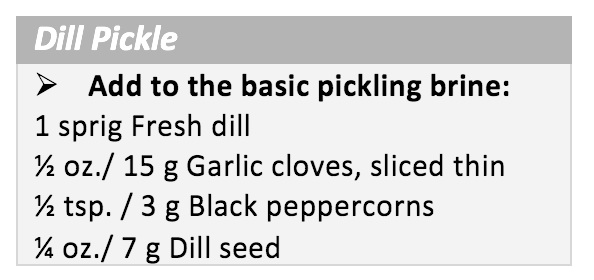Pickling
Pickling is a form of brining used to preserve foods. This practice was thought to have started in India, where the cucumber originated.
Pickling Science
The pickling process is carried out in one of two ways. One method is through anaerobic fermentation in a brine that creates lactic acid. The other method is marinating and storing it in an acid solution, usually vinegar (acetic acid). Although pickling is closely linked with cucumbers, this process can preserve any vegetable. German sauerkraut and Korean kimchi are two well-known pickled foods. The result is a salty, sour taste with sugar, herbs, and spices.
Pickling will preserve perishable foods for months because of the low pH, less than 4.6. Spices, including mustard seed, garlic, cinnamon, or cloves, are added for seasoning because of their reputed antimicrobial effect.
Lactic Acid Fermentation
Sauerkraut
Lactic acid bacteria is naturally present in many foods that feeds on unfavorable bacteria in the pickling process. By salting the vegetables moisture is drawn out of the product producing a brine. The salt prevents other bacteria from growing and allows lactic acid bacteria to digest sugars in the vegetables creating acids that give the pickles their characteristic sour tang.
Kimchi
Natural fermentation in pickling starts with a simple brine of water along with other seasonings, garlic, chilies, peppercorns, and fresh herbs including thyme, tarragon, or dill. The salt solution is 5% of the weight of water or about 2oz. /50g per quart/liter. The ideal temperature range for lactic acid fermentation is 70°F–75°F. Keep the product submerged in the brine to control the oxygen level and prevent unfavorable bacteria from growing.
Fresh Pack Pickling
Pickling in vinegar is a quicker process because there is no fermentation activity. Vegetables, fish, eggs, pork hocks or feet, and sausages are pickled this way. Vegetables and fish are usually pickled raw, while meats need to be fully cooked. The product is either salted or brined for several hours or days, drained, and packed in a vinegar solution that includes salt, sugar, and spices. The acid of the vinegar keeps bacteria at a minimum. White distilled cider and wine vinegar of 5 percent acidity (50 grains) are recommended. White vinegar is preferred for lighter-colored vegetables, including cauliflower. Allow the vegetables to sit in the brine for a week for flavor development. Pickled products can be refrigerated for several weeks but are often canned and heat-processed, extending their shelf life to one year.







